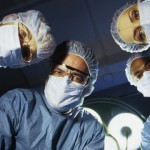Going Under the Knife
 This spring I faced a decision: should I continue dealing with shortness of breath or gamble on a four-hour, tricky heart operation?
This spring I faced a decision: should I continue dealing with shortness of breath or gamble on a four-hour, tricky heart operation?
In his 1920 poem, The Road Not Taken, Robert Frost’s concluding lines speak for many:
Two roads diverged in a wood, and I . . .
I took the one less traveled by
And that has made all the difference.
In life, we all at one time or another have the choice Frost’s poem is about – which path to take. It is not the equivalent of Yogi Berra’s observation: “When you come to a fork in the road – take it.”
A Frost-like choice was mine this spring, with regards to a pacemaker/defibrillator implant in my chest. Shortly after 9/11, when I was anxious to go to Afghanistan and Africa but uneasy that my patched-up heart (two operations and some 11 bypasses over 32 years) might land me in a primitive hospital where AIDS was rampant, Dr. Doug Cameron at Toronto General Hospital (TGH) recommended the defibrillator as an emergency backup for foreign places.
The battery-powered device fed a couple of wires into the left side of my heart, in case I ran into trouble and needed a jolt of electricity. It worked well, never kicked in, but was reassurance and helped the ailing pump.
A couple of years ago, starting shortly after being in Afghanistan, I became chronically short of breath. Not only did my tennis game disintegrate, but I had to pause while walking to catch my breath.
Even to me, I began to sound old and wheezy.
I consulted Dr. Cameron and TGH cardiologist, Dr. Heather Ross, and wondered if age was finally catching up with me. Independently, they thought if an additional wire went from the implant into the right side of the heart, it might help the left and right ventricles pump in harmony.
My trouble was that I wasn’t getting full value from the heart, beset as it was with fibrillations or whatever they call irregular heartbeats. (I don’t have much hypochondriac in me, so am uncertain of medically correct terms).
I was sent to take tests from a doctor at Mt. Sinai Hospital, associated with TGH in the University Hospital Network (UNH). His diagnosis: Exercise and lung tests showed I was close to the maximum for my age. He felt I wouldn’t gain much by the additional wire, which was more complex and difficult to insert than the wire on the left side of the heart.
He made sense to me, so I figuratively shrugged and prepared to endure.
That was last year. This year, during a routine check by Dr. Ross – whom I admire greatly for taking heart transplant patients to climb the Andes mountains in South America and sledding to the North Pole – she raised the proposition of being operated on to put the extra wire into my heart.
It was a Robert Frost moment – which path to take? Continue making do with shortness of breath, or gamble on a four-hour heart operation? I wondered why the previous doctor argued against it. Dr. Ross was careful, but I got the impression the other doctor didn’t think such measures should be done on old gaffers, but reserved for younger people. Hmm.
“I don’t view you as old,” said the indomitable Heather. “You’ve got a lot of mileage left.” I’m not certain the loony left would agree, but for me, the choice was no choice: Go for it.
I was warned the procedure might not work, and might take up to three months to kick-in and improve the breathing. It was a worthwhile gamble.
I was in hospital for nine days, waiting for the blood count to be right. The surgery itself was interesting. I was conscious throughout, but told I wouldn’t remember anything. But I did. I could hear (and feel) surgeon Dr. Kumaraswamy Namthakumar, muttering away and hammering my chest to get the implant under the skin. It didn’t feel like four hours but did feel like a pile driver.
For what it’s worth, after the operation I instantly – and I mean instantly – was breathing better and couldn’t recall what being short of breath was like. Dr. Nam acknowledged that the operation was tricky (it’s apparently easy to puncture the lung or heart) but he was “immensely pleased” with the result.
That was a couple of months ago. Oh, I wound up with gout in the hospital, but that’s a mere nuisance. I’m now eager for tennis, my voice is nasal as usual but strong, breathlessness is gone, I feel ready for Afghanistan again. And it cost me nothing.
Say what you like about Canada’s “socialized” healthcare, over the years I’ve found everyone at TGH – floor cleaners, food servers, clerical staff, nurses, doctors – to be friendly, helpful, patient. We “customers,” on occasion, can be demanding, unhappy, grumpy.
To return to Robert Frost: When it comes to a choice in the road, my advice is the same as Yogi Berra’s: Take it. You never know where it will lead.